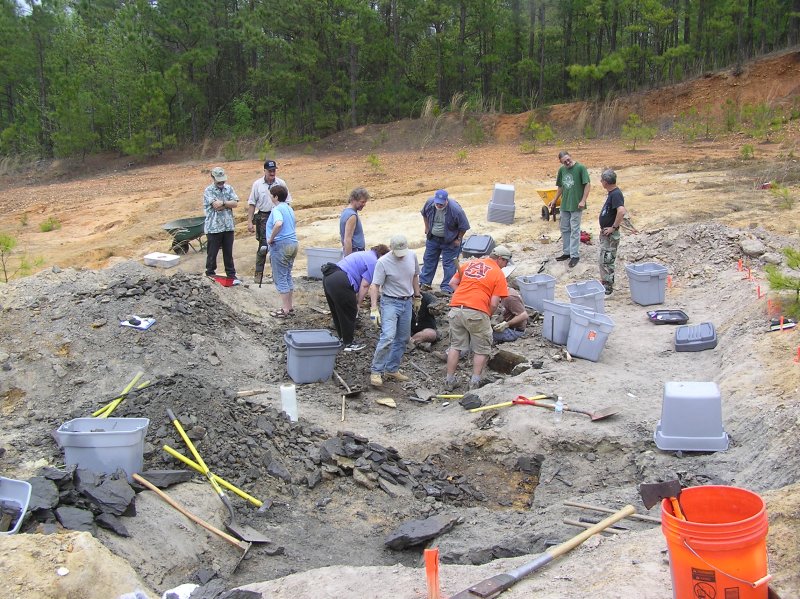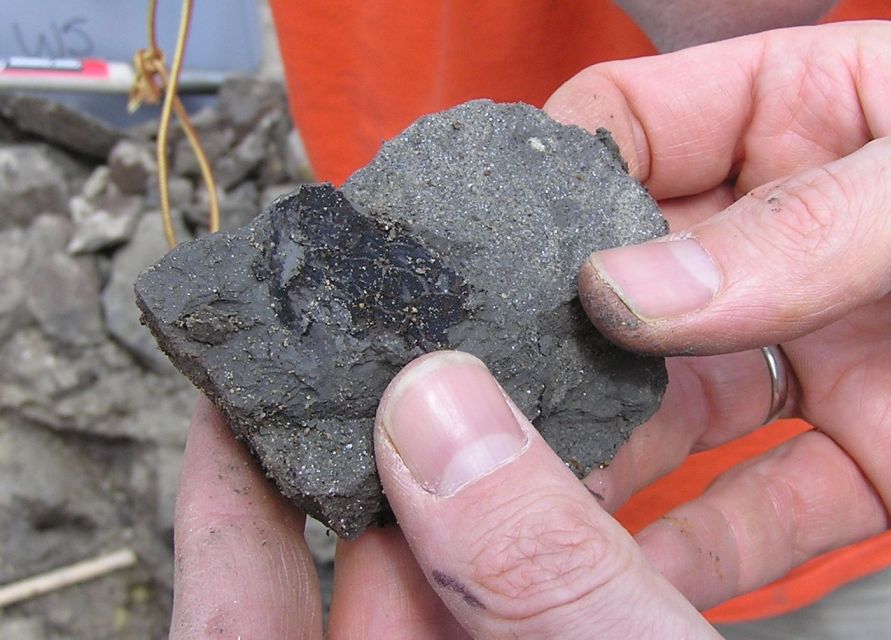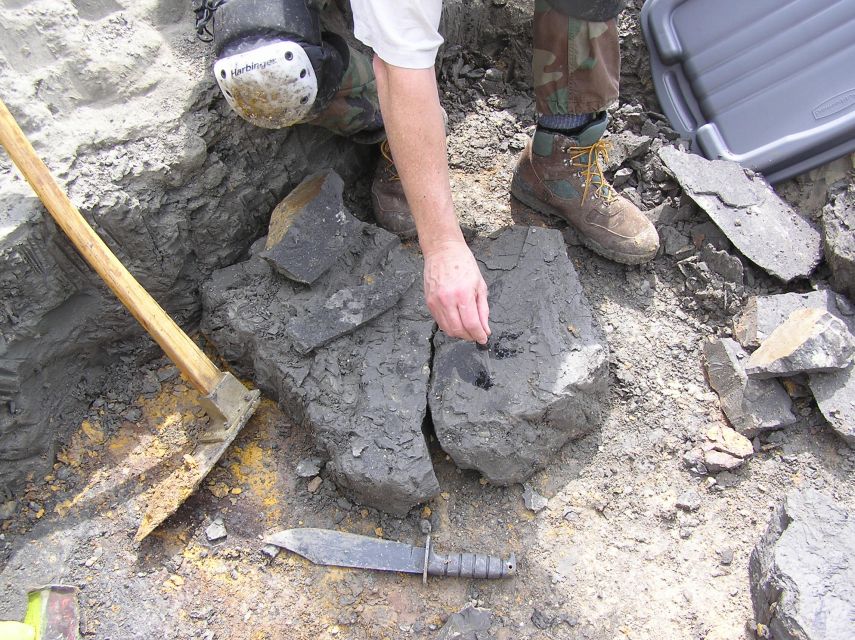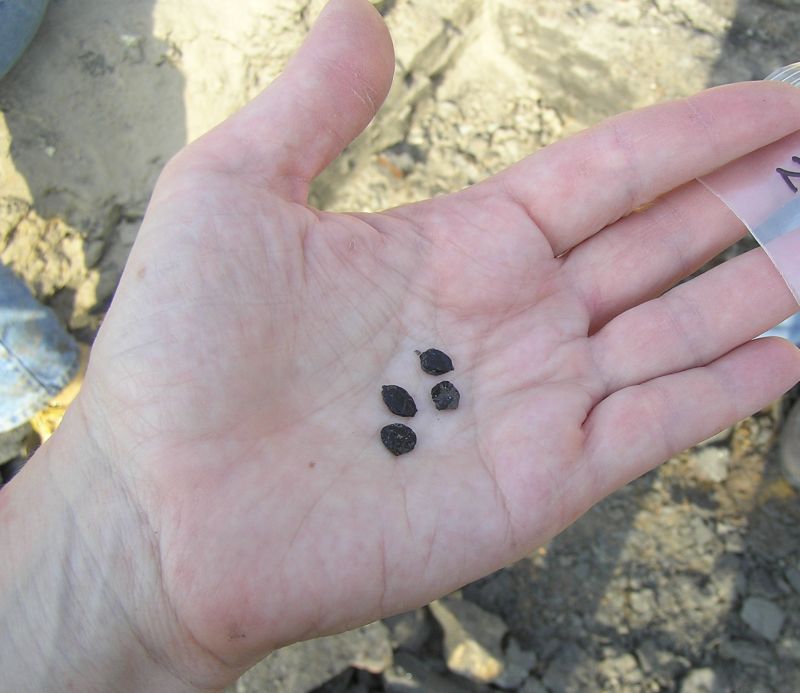April 1, 2006 - Cretaceous Fossils, Russell Co, AL
This Cretaceous site is slated to become a subdivision in the near future, so a dig to excavate and conserve material from the best layers was organized and coordinated by Patrick Sean Bingham, a grad student at Auburn University. Patrick's thesis topic is “Stratigraphic and Paleoenvironmental Context of the Ingersoll shale, an Upper Cretaceous Conservation Lagerstätte, Eutaw Formation, Eastern Alabama”. Another grad student from Auburn University, Terry Knight, was also working on his thesis, “Exceptionally Preserved Soft-Bodied Fossils of the Ingersoll shale, an Upper Cretaceous Konservat-Lagerstätte in the Eutaw Formation of East-central Alabama".
Many well known professionals from around the country volunteered their time and expertise to assist on the dig, including Dr. David Grimaldi and Collections Manager Carl Mehling from the American Museum of Natural History in New York City. Dr. Grimaldi was especially interested in the nice specimens of amber found at the site. Others who provided assistance and knowledge were Dr. Chuck Savrda and Dr. Ron Lewis, both from Auburn University, Dr. Bill Bevil from the Fernbank Museum of Natural History, Atlanta, Ga, and Dr. Bill Frazier, Dr. David Schwimmer and Dr. Dent Williams, all from Columbus State University, Columbus, GA.
It was a real treat to work with these professionals and others who participated in the dig, and everyone got “down and dirty”, quite literally, as various plant leaf and stem impressions, some actual leaves, fish scale impressions, and even pieces of amber were unearthed!
(Editors note: Research on this site is described in the June 2008 issue of Palaios Journal, and some excellent photos are shown on the cover.)
(Photos courtesy Vicki Lais)

An overview of the dig location. Several feet of overburden was removed with a small bulldozer prior to the manual digging with picks and shovels.

Patrick Bingham explaining the geology of the site to Dr. Henry Barwood.

Overview of the site. Material was placed in the large tubs and taken back to the university for research. Note the orange spikes on the far right - the site was gridded, and one layer was designated "the middle", so some of the material is "above" or "below" that layer.

Numerous Cretaceous leaf impressions were found at the site.

BPS members observe the dig operation and look through the discard pile for samples to collect. Later in the day, we were allowed to help load tubs and Greg assisted with the excavation.

Terry Knight is keeping a log of the geologic layers as they are removed.

Dr. John Interlandi with the pick and Dr. David Grimaldi examining leaf specimens.

Dr. Bill Frazier (far right) observing the dig operation.

Humm . . . . did we miss any?? Better check those rocks carefully! Left to right - Vicki Lais, Bill Montante in back, Carl Mehling in black in front, Dr. Chuck Savrda, Dr. Bill Frazier, Terry Knight, Amanda Savrda.

Amanda Savrda, Dr. Chuck Savrda, Michael Brocato, and Leisa Whitlow observing the diggers.

Dr. David Grimaldi getting an up close look.

Beautifully preserved fossil, one can see scales using a magnifying glass.

A well preserved mussel impression, including the foot.

This fossil leaf was quite long, more was exposed as the overburden was removed.

Dr. John Interlandi is applying a fixative to a fossil leaf to help preserve it. This clay material is damp when excavated, but the hot sun dries it out quickly. When it dries, the exposed surfaces crack and curl up like dried mud, destroying any fossil that might be there.

Large exposure of matted leaf material.

Another plant fossil.

Several leaves.

This is an extension of the long stem/leaf shown several pictures above.

Dr. Grimaldi (author of Amber: Window to the Past) was specifically hunting amber, and he was not disappointed, as several pieces were found. Many of the amber pieces contained inclusions of small insects.

Seeds found at the site.

Most of the previous photos capture impressions of ancient fossils - where the fossil used to be, and now there is only an image pressed into the clay. This photo shows an actual leaf which was preserved in the soft clay, note the curled up edge of the leaf.
